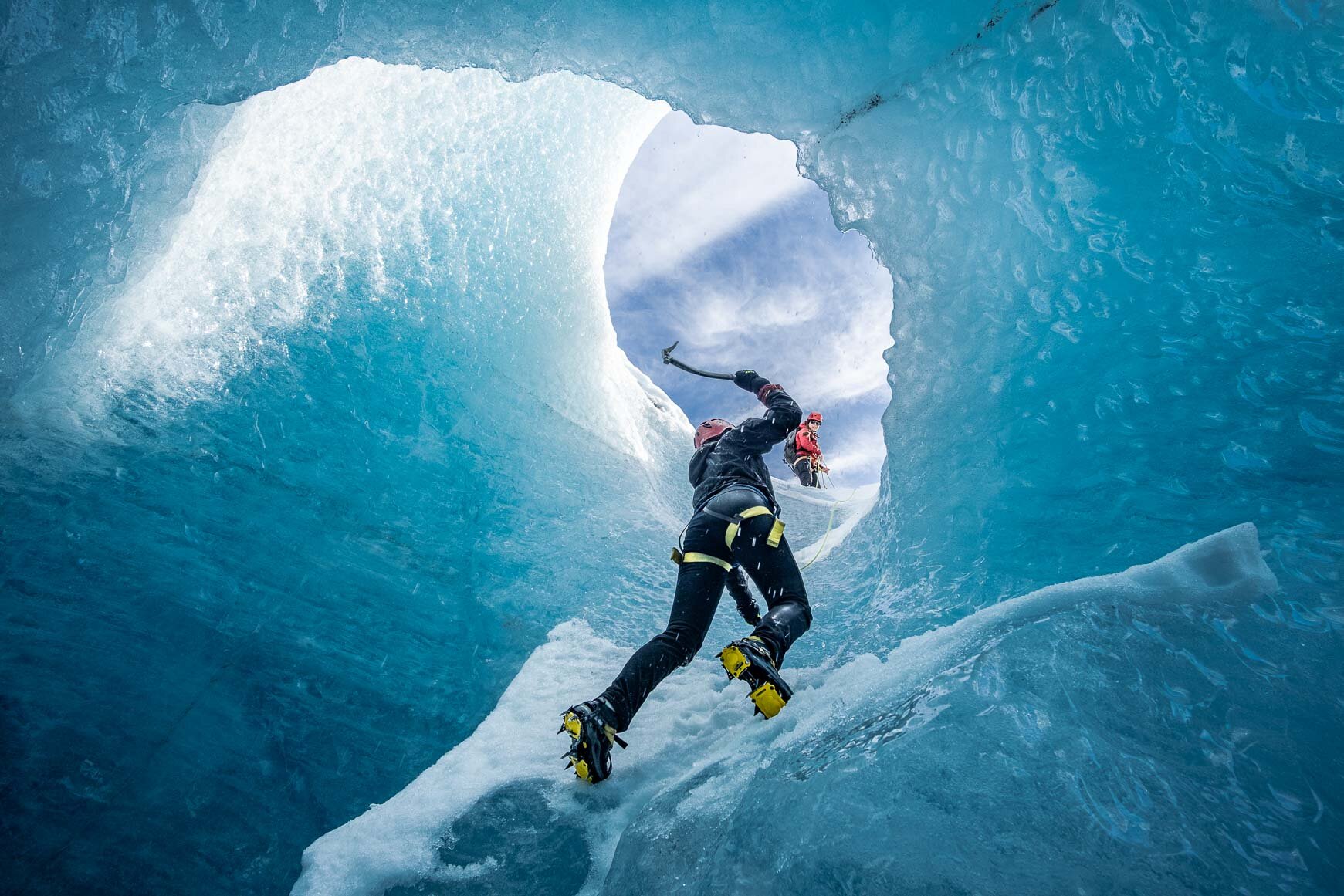
Tips and Tour Information on
Icelandic Ice Caves
Glacier ice caves are one of the most impressive natural wonders that visitors can experience here in Iceland. The Best Ice Cave Guide to Iceland aims to answer the frequently asked questions and provide all of the information that you need to know before visiting a natural glacier ice cave in Skaftafell, Vatnajökull National Park.
Contents
Can I combine my ice cave tour with other glacier activities?
Am I allowed to visit an Ice cave in Iceland without a guide?
For more general information on glacier tours please visit
The Best Glacier Tour Guide to Iceland
Vatnajökull Ice Cave
& Glacier Hike
Hike to explore an ice cave beneath the glacier.
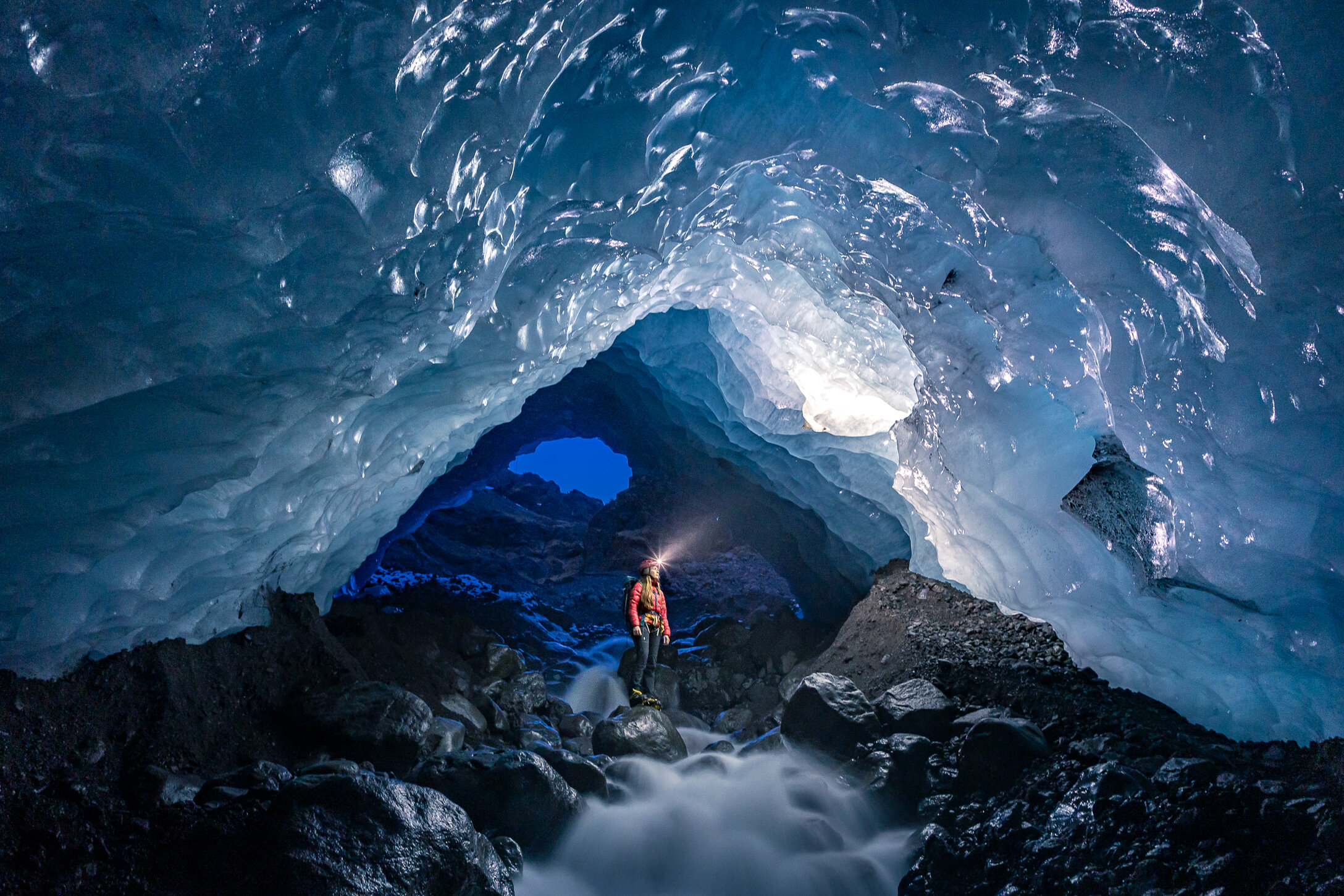
What exactly is an ice cave and how is it formed?
All ice caves in Iceland lie within or beneath glaciers. These caves are formed by the meltwater of the glacier that flows through the ice during periods of rainfall or during the warmer months when the glacier ice is melting. Glacier and Volcano Expeditions define an ice cave as a hole on a glacier that a human being can fit inside and have an ice "roof” above their head. This means that a cave can be large enough for one small person to squeeze inside, or it can be so big that an entire freight train could fit in!
All of the glacier ice caves are constantly changing as the glacier melts and moves. The most fascinating part of guiding glaciers and ice caves is having the opportunity to witness these natural processes. However, these natural processes also come with a degree of challenge for all of the ice cave guiding companies, including Glacier and Volcano Expeditions, as the environment that we operate tours within is inconsistent.
There are three types of glacier ice cave:
Subglacial ice caves
Subglacial caves lie right at the very bottom of the glacier so when one enters the cave they will usually be walking beneath the glacier on the rocky bed surface that the glacier lies on. These caves are formed either from water that flows out from beneath the glacier, or from water that flows down beneath the side of the glacier from an external source. Generally subglacial ice caves are only accessible during the colder winter months when there has been low amounts of rainfall.
Surface ice caves
Surface ice caves are usually located at the surface of the glacier and are formed as water and air melts a hole through the ice, melting the glacier on the inside and therefore creating a cave. Surface ice caves can be found on the glacier all year round, however they are very susceptible to melt due to warm air temperatures, sun exposure and rainfall. Surface ice caves tend to generally be smaller in size than the subglacial ice caves but they often provide a more “icy” cave experience as surface ice caves usually consist only of ice, as opposed to the rocky floor of the subglacial ice caves.
The photography potential for surface caves is fantastic as there is generally a lot more light available and the absence of rocks on the floor of the cave can provide a more aesthetically pleasing image.
Compression arches
Compression arches are caves that are formed due to surface tension on the glacier as the ice is compressed beneath an icefall. The result is an arch with a similar structure to a bridge. Compression arches can be found at any time of the year on the steeper glaciers. Compression arches are a very intriguing glacial formation and it is always interesting to pay them a visit.
The best time to visit an
ice cave in Iceland
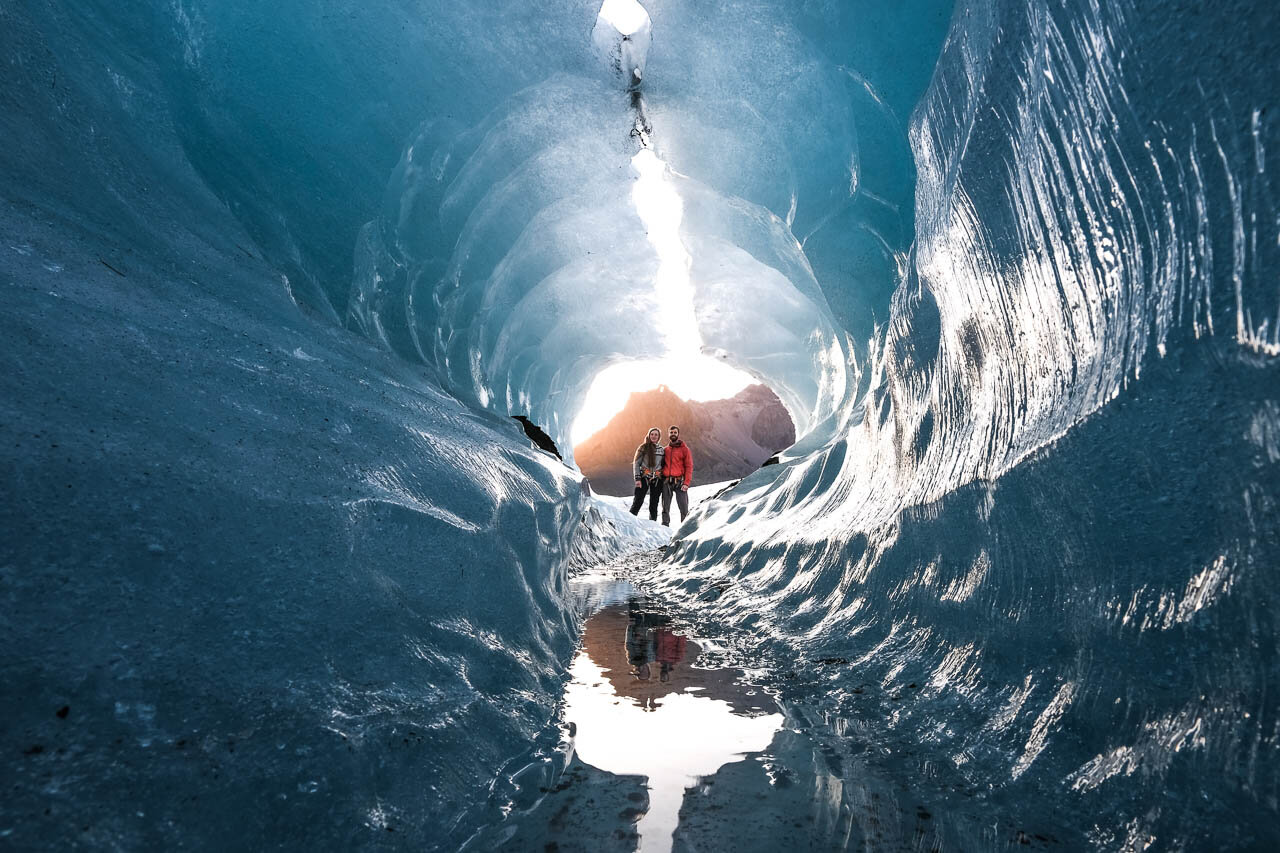
When is the best time to visit an ice cave in Iceland?
There is no better time than now!
There are some ice cave tour options that are accessible all year round and some of these particular ice caves may require a physically challenging hike to reach them so the tour participants must be active people in good physical shape.
The winter months (from November through to March) are generally the best time to visit an ice cave simply because there are more ice cave options available, there is generally less melting that is occurring on the glaciers and the ice caves that exist tend to last longer.
However, as the glaciers and conditions are constantly changing here in Vatnajökull National Park, guides often discover small “surface” ice caves all throughout the year. Surface ice caves are unique formations that can form and melt away quickly, or last a surprising length of time. Some surface ice caves are only safe to enter on the day that we discover them whilst others may last for longer than a month or two depending on the structure of the cave and the conditions.
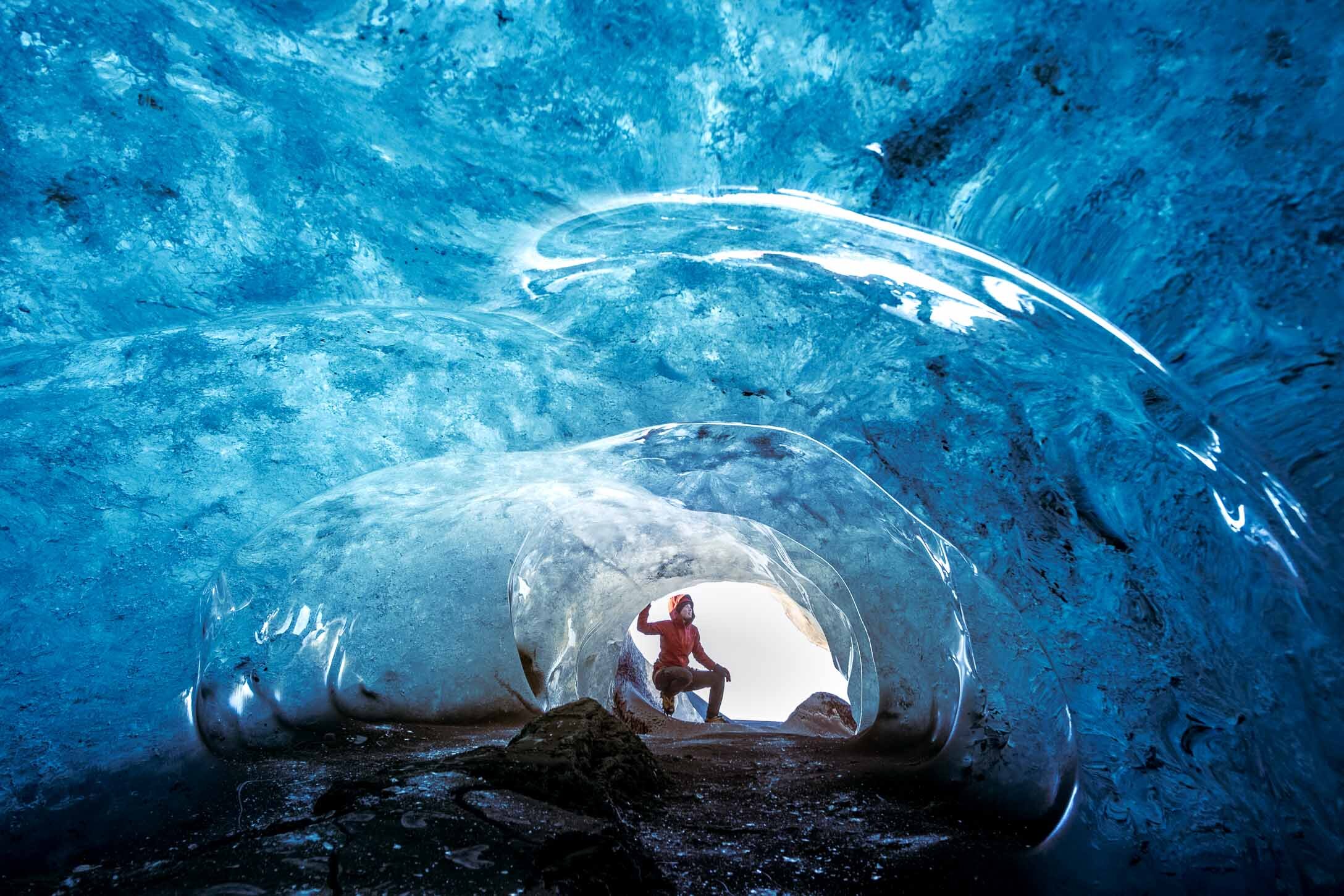
Are Iceland’s ice cave tours accessible in summer?
Yes! Despite the general rule that winter is considered the best time to visit an ice cave, there are definitely some advantages to visiting an ice cave in summer. The warmer temperatures make outdoor activities more comfortable and longer daylight hours mean that you can fit more adventures into your travels here in Iceland.
To increase your chances of visiting an ice cave, Glacier and Volcano Expeditions recommend that you book a longer glacier hike or ice cave tour of around six hours as these are discovery-style experiences where you will be actively searching for new ice caves during the tour as well as visiting the ones that we already know of. Often the best glacier features lie several kilometres hike up the glacier. These features can be time-consuming to hike to which is why we recommend making a reservation for a longer tour. If you would like to know how the ice cave situation is right now, please don't hesitate to contact us for an update.
Explore beneath the ice
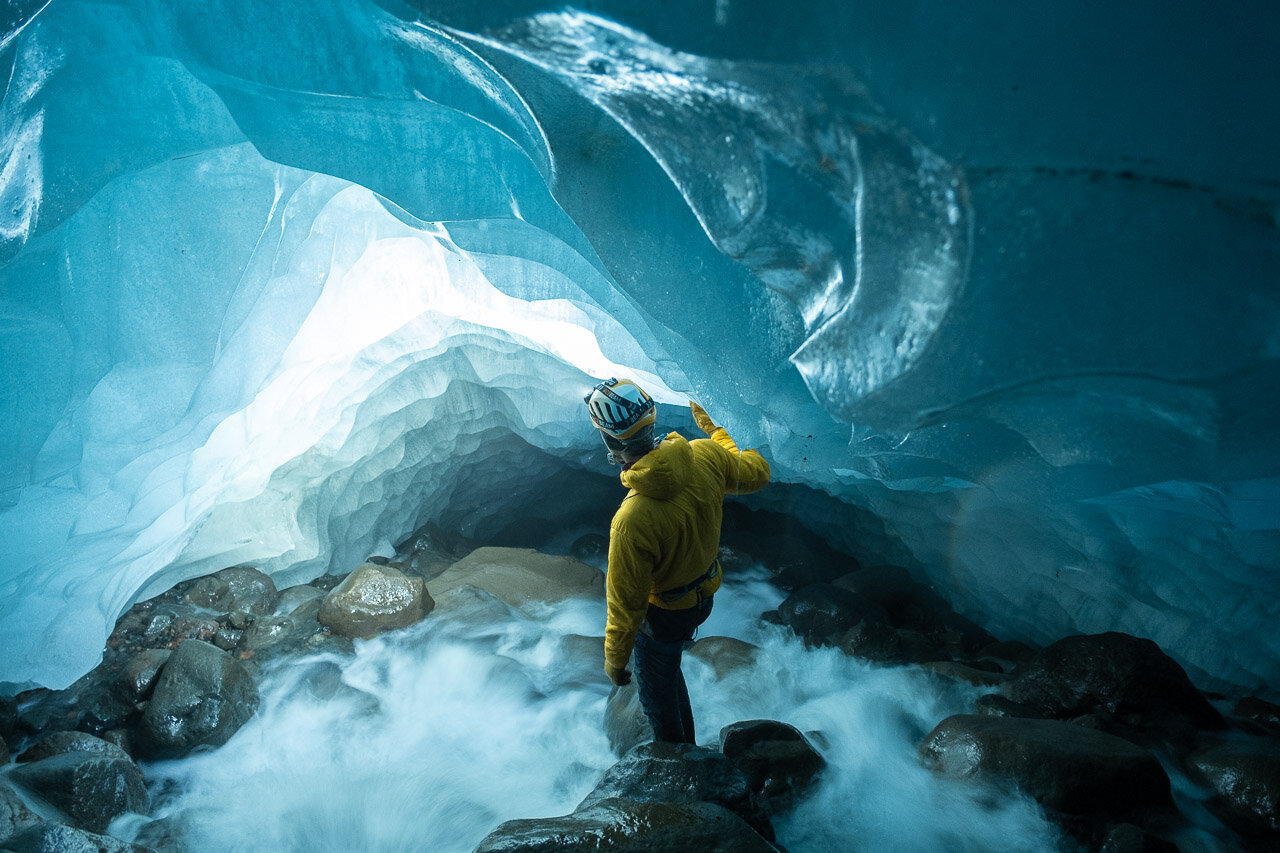
Where are the best ice caves
located in Iceland?
Vatnajökull Glacier is where the majority of ice cave tours take place in Iceland and where the best ice caves are found. Some of the outlet glaciers form accessible ice caves consistently in a similar location every winter whilst other glaciers can be more sporadic and form caves in random locations. This means that we are constantly searching for new ice caves which makes it an interesting job for us as ice cave guides!
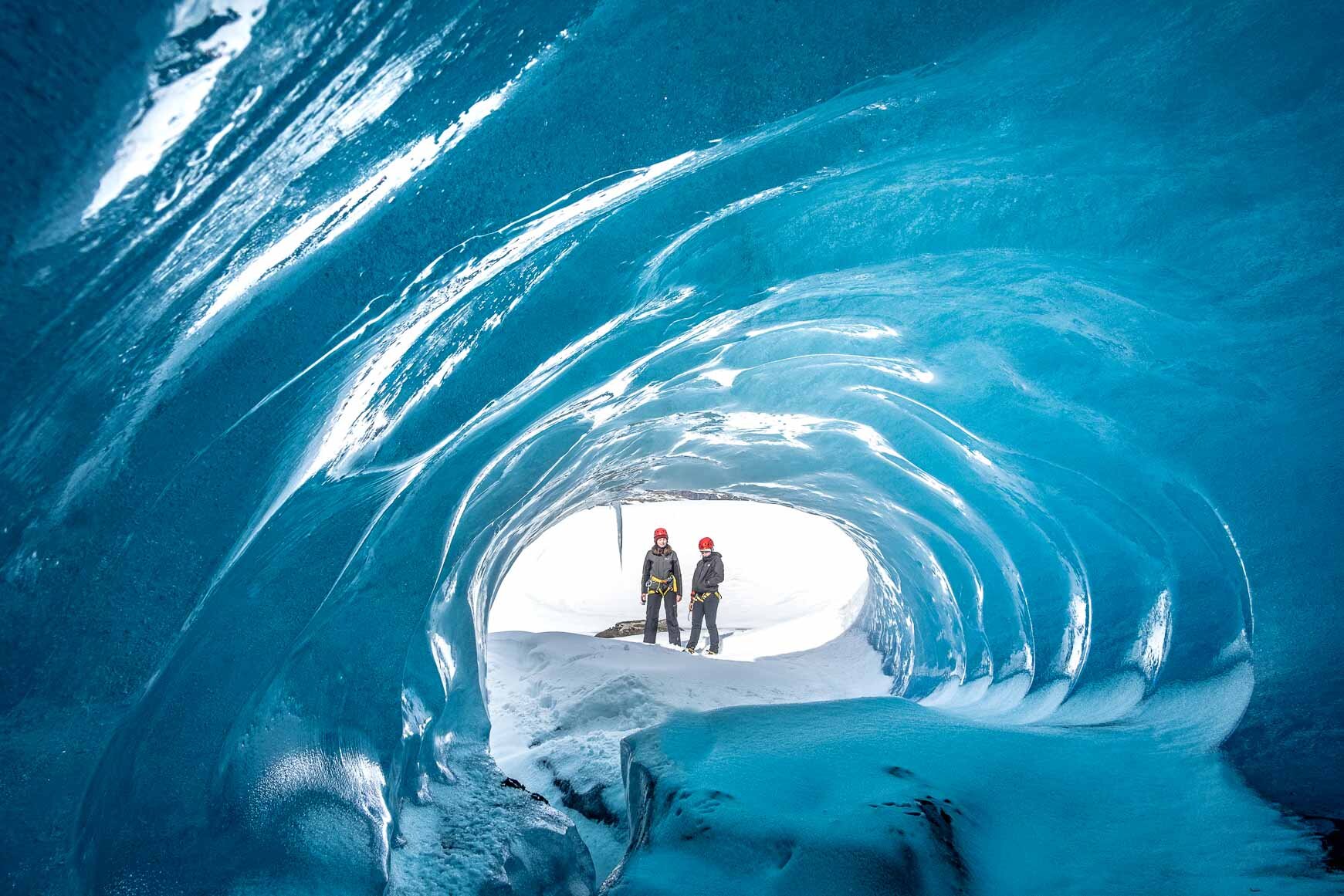
How should I be prepared for an ice cave visit?
Ability levels
Walking up and onto an Icelandic glacier or volcano with Glacier and Volcano Expeditions requires a degree of physical effort and ability which varies depending on the nature of the adventure that you embark upon. We do our absolute best to ensure the safety and comfort of all our guests but it is important that your choice of tour is appropriate for your level of physical ability. It is very important that you notify us of any medical issues or injuries that you may have. For more information regarding ability levels, click here.
Correct footwear for the glacier
Correct footwear is probably the most important part of equipment that we require our guests to bring with them on a glacier hike. Glacier and Volcano Expeditions does not have a boot rental service therefore it important for you to consider the type of footwear you will bring for the glacier trip.
Correct footwear directly affects your comfort and safety on the glacier. If you wear suitable boots that are designed for the style of terrain that you are walking on you will be significantly more stable when walking on the ice.
Throughout the year you can expect to encounter mud, water puddles, streams and rain that will wet your feet so it is best to have solid, waterproof boots for glacier hiking. For more information regarding correct footwear, click here.
Appropriate clothing for a glacier tour
It is important to wear appropriate clothing on the glacier so that you are warm, dry and comfortable. A waterproof jacket is mandatory and Glacier and Volcano Expeditions highly recommends bringing waterproof overtrousers. Iceland can be wet and windy at any time of the year and your choice of clothing can make or break your glacier experience!
It is common for people to overdress on a glacier hike and although this is usually not a major issue, it is important that you have a backpack with enough room to stash additional layers that you remove as a result of getting too hot during the hike. For more information regarding appropriate clothing, click here.
Ice cave photography

How to take outstanding
photos in an ice cave
in Iceland
Ice caves are one of the most incredible natural phenomena that both professional landscape photographers and casual photographers can enjoy shooting. With just a few simple adjustments you can dramatically increase the quality of your images and create something truly unique.
Ice cave photography is slightly different to daytime landscape photography. Ice caves are often dark inside, but they also often have light sources such as the openings that can produce a huge range of light which can be difficult to manage. As with all photography, composition is one of the most important things. Luckily, the Glacier and Volcano Expeditions guides are also professional photographers (who have shot all of the images on this website) and can help with setting up good camera angles. There are also some things to consider before you come on the ice cave tour.
For inspiration, please visit the Vatnajökull Photography Gallery
Photography equipment for ice caves
Tripod - when shooting with any type of camera it is best to stabilise it so that you can utilise longer shutter speeds.
Protective lens (UV) filter - as the ice caves are usually full of fine glacial dirt deposits and volcanic ash, it is probable that your lens will get dirty. This dirt will scratch the lens when you wipe it off so it is best to have protection for your lens glass.
Microfibre cloth - ice caves are wet and dirty. You don't want to be caught out with water and dirt all over your lens without a way to clean it off.
Wide lens - in order to capture as much detail in the ice as possible bring a wide lens.
Head lamp - head lamps are a great help for setting up your gear in the cave, changing camera settings and they can also help to create cool light effects inside the cave.
Spare battery - some batteries die quite fast in the cold; don't get caught out with a flat battery!
Spare memory card - for just in case your card fills up faster than you anticipated.
The best camera settings for ice cave photography
There are many things to consider with ice cave photography as you may need to combine several different photography disciplines into one for this unique setting. In winter time, ice cave photography usually resembles a mixture of night photography with landscape photography. Luckily, we are here to help! Glacier and Volcano Expeditions have been photographing ice caves for many years now and we are always more than happy to give friendly advice, provide ice cave photography workshops and even model for your shots!
Ice cave ice climbing!
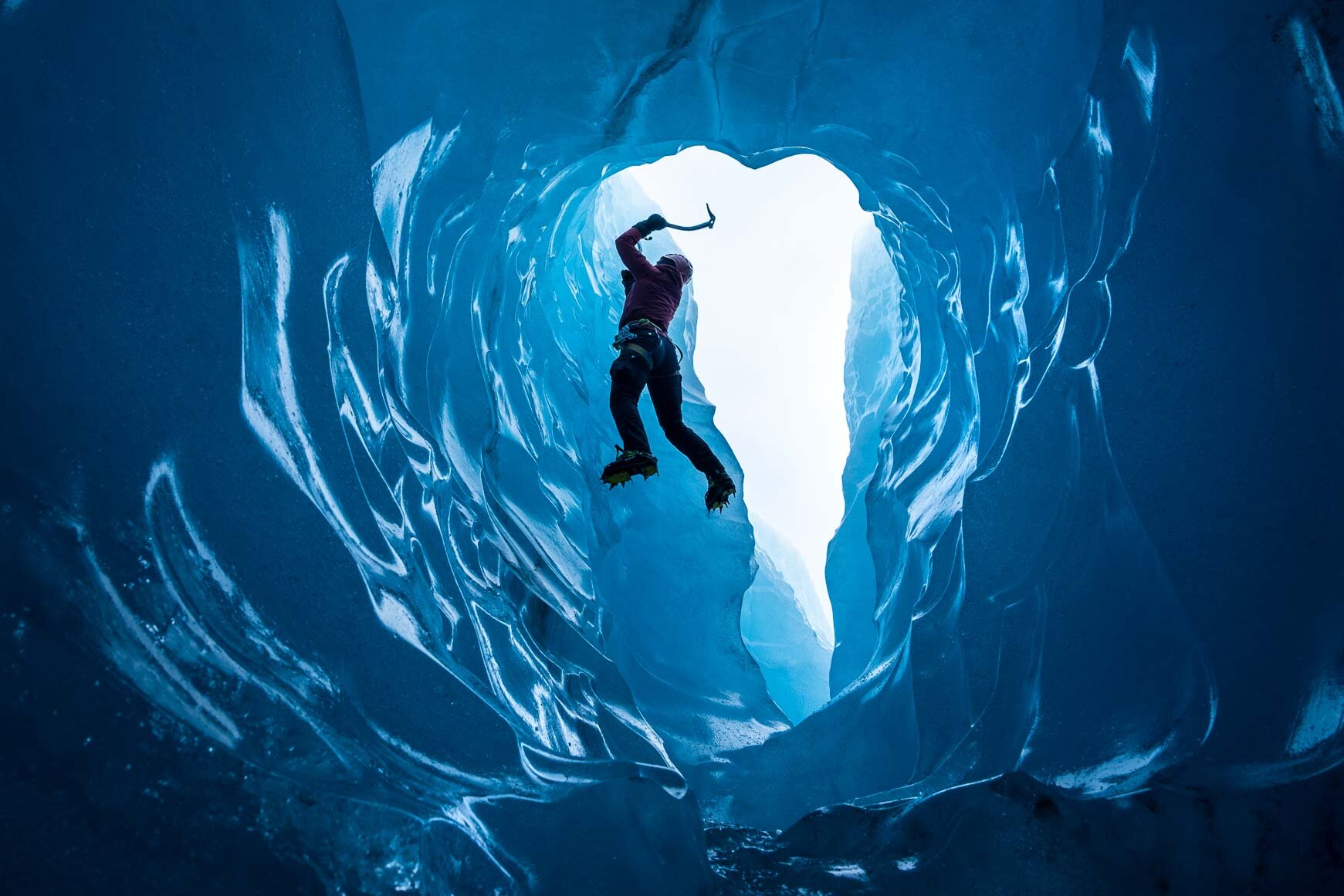
Can I combine an ice cave
tour with other glacier
activities?
Absolutely! Glacier and Volcano Expeditions specialise in providing unique experiences and we love to be creative with the tours that we guide. Some of the possibilities are:
Ice cave and glacier hike combined with ice climbing
Ice cave and glacier hike combined with ice climbing and photography
Glacier kayaking and glacier hike and ice cave combination (conditions dependent)
Glacier hike and ice cave visit with Iceland mountain hike
Extra-adventurous full day ice cave tour
These experiences are conditions-dependent, bookable as private or custom tours and are subject to the weather and glacier conditions. For further information please do not hesitate to contact us.
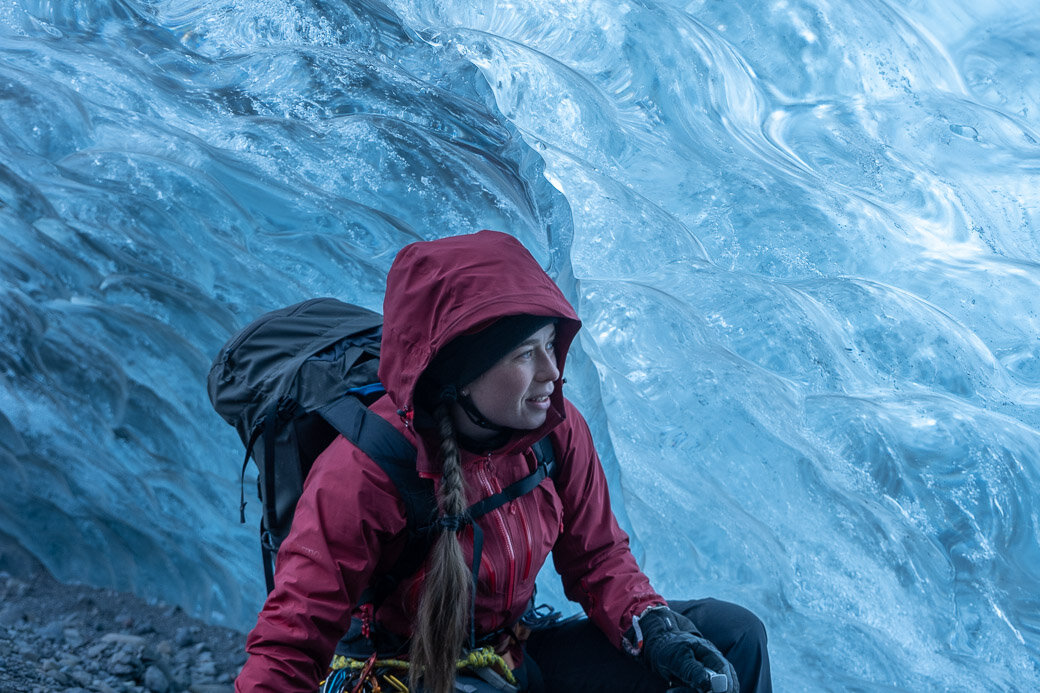
Can children join an ice cave tour on Vatnajökull glacier?
Absolutely!
Children are certainly welcome on Iceland’s glaciers, however there are some things to consider before booking your tour, such as:
The age of the children - all of our tours have a minimum age requirement. The minimum age is designed to keep the children safe, comfortable and to not slow down other participants in the group.
Your children’s fitness ability and experience level - if your children have never been for a hike on a mountain before it would be best to contact us for further information and advice.
What if the children are younger than the minimum age for the tour? Consider contacting us to make a reservation on our Iceland Private Glacier Tour. We will then be able to cater to your individual requirements with a private tour and children of any age will be welcome.
It is always best to contact us if you would like to make a family reservation so we can make sure that you are booked onto a suitable tour.
Glacier and Volcano Expeditions can provide you with the ultimate glacier experience here in Iceland
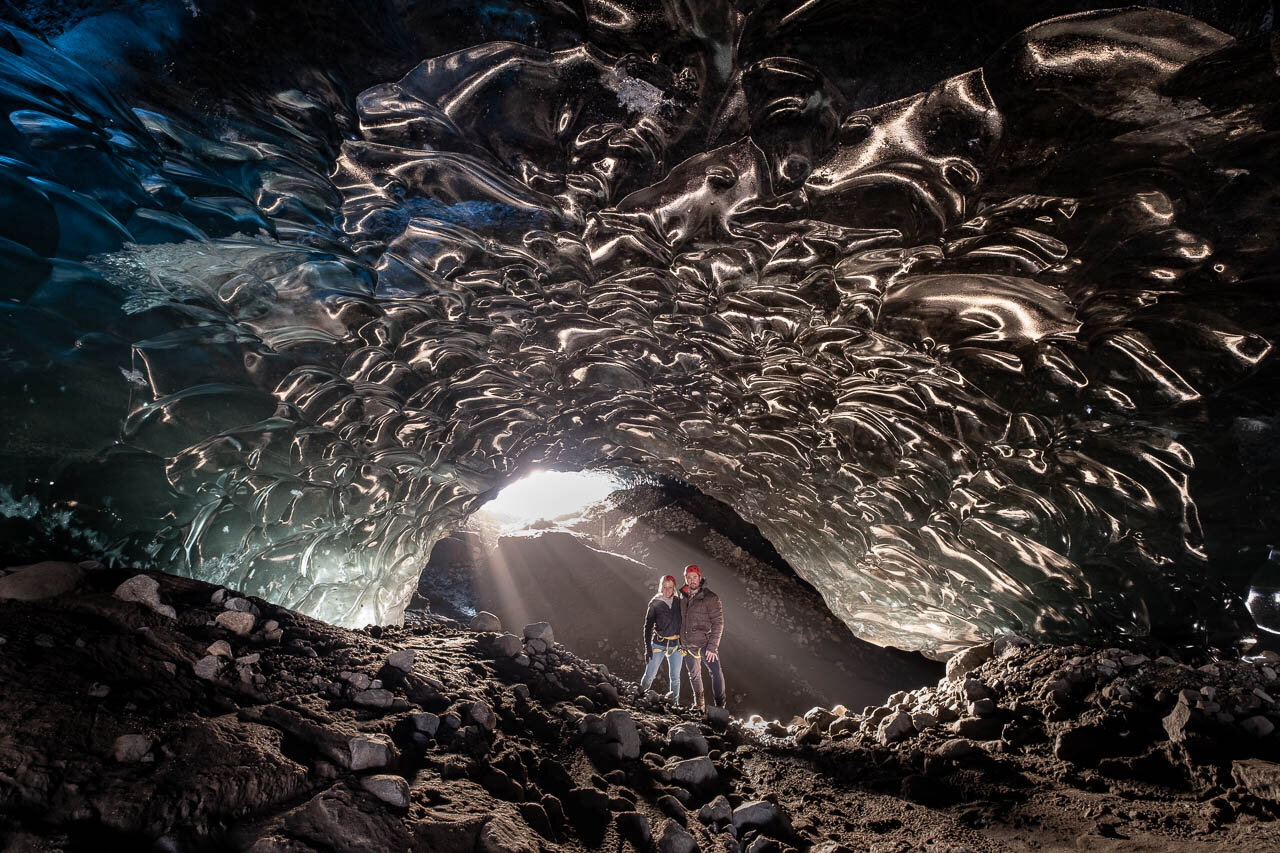
Can I visit an ice cave in Iceland
by myself?
Is it possible to visit an ice cave without a guide? The simple answer to this question is yes. The general public are legally free to roam anywhere within Vatnajökull National Park at their own risk.
At your own risk you may try to locate an ice cave and keep yourself safe if you are experienced with alpine environments. Please take into consideration that Vatnajökull National Park is one of the most dynamic and changeable places on Earth and the natural processes that are present here can pose significant hazards to people who venture into the wilderness.
To safely return from a visit onto an Icelandic glacier one must be trained and experienced in the following: rockfall mitigation, assessing glacial terrain and hazard mitigation, correct use of crampons and glacier equipment, safe glacier route finding, weather and natural conditions assessment, river crossings, frozen lake ice assessment, snow safety and also have knowledge of crevasse rescue and first aid in an event of emergency. One must also be prepared with all of the necessary equipment such as ropes and climbing hardware, first aid equipment, satellite communication devices and be competent in using all of this equipment.
If you are competent with the above and prepared for all of the possible situations and you do discover an ice cave it is highly recommended that you are also competent in assessing the structural integrity and associated hazards of the ice cave before even going close to the cave. Life threatening hazards such as rockfall, crevasses, rivers, cave collapse and noxious gasses may be present and therefore Glacier and Volcano Expeditions, Vatnajökull National Park and the Icelandic Search and Rescue Team (ICESAR) recommend that you do not enter an ice cave unless you are highly experienced in making an adequate safety assessment and mitigating the hazards that may exist.
We therefore recommend that you book an ice cave or glacier tour with Glacier and Volcano Expeditions so that you can be assured that all of the safety aspects of your glacier and ice cave experience will be taken care of and you will return from Vatnajökull National Park happy and healthy.
The Glacier and Volcano Expeditions guides are certified with the Association of Icelandic Mountain Guides (AIMG) and also the New Zealand Mountain Guiding Association (NZMGA). We have been proudly guiding glaciers and ice caves for many years and we are also active members in the Icelandic Search and Rescue Team (ICESAR). Rest assured, you can have confidence that you are in capable hands and that you will be provided with a memorable experience with the highest possible standard of glacier safety.



